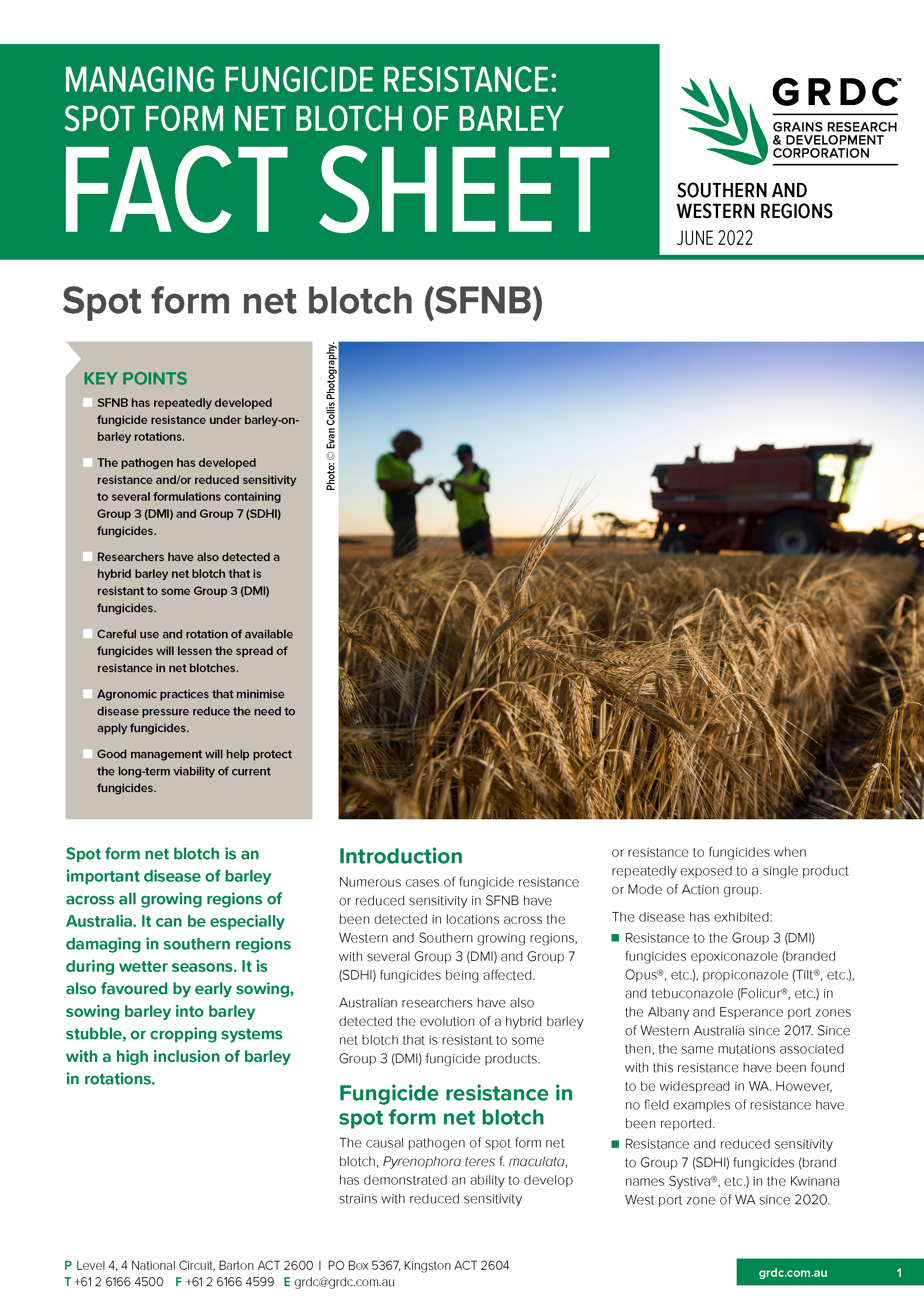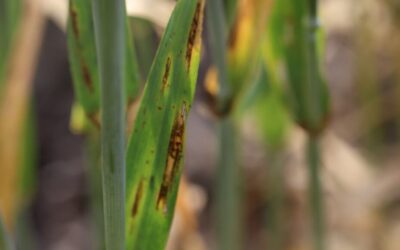BARLEY
Spot form net blotch (SFNB)
Pyrenophora teres f. maculata
Manage
disease pressure
Minimise
fungicide use
Engage
with extension
Spot form net blotch (SFNB)
Pyrenophora teres f. maculata
Spot form of net blotch (SFNB) is an important disease of barley across all growing regions.
It is particularly damaging in wetter years in the southern regions, in early sown crops and systems with high inclusion of barley in rotations, and where barley is sown into barley stubble. Severe infections can cause 10–45% yield loss and significant reduction in grain quality.
SFNB is typically favoured by susceptible hosts, mild weather (15–25°C) and extended periods of leaf wetness. It survives between seasons on stubble.
Resistance status
Resistance – Group 3 (DMI) fungicides epoxiconazole, propiconazole, prothioconazole and tebuconazole in the Albany and Esperance port zones of WA.
Resistance – Group 7 fungicide fluxapyroxad in the Kwinana West port zone of WA.
Reduced sensitivity – Group 3 fungicides epoxiconazole, propiconazole, prothioconazole and tebuconazole in WA.
Reduced sensitivity – Group 7 fungicide fluxapyroxad in the Kwinana West port zone of WA.
Lab detection – dual reduced sensitivity to both the Group 3 fungicide tebuconazole and Group 7 fungicide fluxapyroxad in the Kwinana West port zone of WA.
FACT SHEETS
Spot form net blotch
Spot form net blotch is an important disease of barley across all growing regions of Australia. It can be especially damaging in southern regions during wetter seasons. Numerous cases of fungicide resistance or reduced sensitivity in SFNB have been detected in locations across the Western and Southern growing regions, with several Group 3 (DMI) and Group 7 (SDHI) fungicides being affected.
Fungicide resistance in barley
Net form net blotch, spot form net blotch and powdery mildew are important diseases of barley that have exhibited fungicide resistance. All fungal diseases of barley have the potential to develop resistance to any single-site fungicide that is used repetitively. Adopting integrated disease management and fungicide usage practices now will help preserve the effectiveness of these useful chemicals.
Fungicides in Australia
Fungicides are a valuable tool in crop protection worldwide. However, most are vulnerable to the pathogens they target developing fungicide resistance, so responsible management is essential for preserving ongoing efficacy. There is a limited number of fungicide Mode of Action groups registered for use on crops in Australia.
Fungicide resistance
Fungicide resistance is a serious issue that can affect crop yields in the short term, while impacting on the long term viability of registered fungicides. Understanding how fungicide resistance develops, how it places additional pressure on other fungicides, and how fungicide use should be managed to minimise risk is vital for protecting future crop yields.
SDHI resistance in barley net blotches
Succinate dehydrogenase inhibitors, or SDHIs, are some of the most effective chemistries to grace the market in recent years for the management of net blotches in barley. The problem is, they are already under strain in the Southern and Western Regions.
Northern region
Southern region
Western Region
WEBINARS
Net blotches of barley
Thursday 4 April 2024
An update on monitoring of net and spot form net blotch resistance to fungicides with Dr Hari Dadu, research scientist, Agriculture Victoria, and Dr Tara Garrard, Sub-Program Leader Cereal Pathology, SARDI. Fungicide resistance in net blotch is widespread and it varies a lot. Variety choice is a key management strategy.
Queensland
Monday 14 August 2023
AFREN Update Webinar Qld: University of Southern Qld researchers Professor Levente Kiss and Dr Noel Knight and CCDM’s Dr Fran Lopez Ruiz provide an update on fungicide resistance detections in mung bean powdery mildew, net blotches and wheat powdery mildew in Qld.
Western region webinar
Thursday 19 August 2021
AFREN Fungicide Resistance WA webinar with Dr Fran Lopez-Ruiz from the Centre for Crop Disease Management (CCDM) and DPIRD specialists Geoff Thomas, Dr Kithsiri Jayasena and Andrea Hills.
NSW/Qld webinar
Friday 24 July 2020
Australian Fungicide Resistance Extension Network (AFREN) Fungicide Resistance in NSW/Qld webinar by Steven Simpfendorfer, NSW DPI, Lisle Snyman, DAFQ and Levente Kiss, Centre for Crop Health, USQ.
WA webinar
Thursday 27 August 2020
AFREN Fungicide Resistance in WA presented by Geoff Thomas, DPIRD, with CCDM’s Wes Mair and Fran Lopez Ruiz and Kith Jayasena, DPIRD.
2020 SFNB SDHI resistance in WA - update webinar
Friday 2 October 2020
AFREN update on spot form net blotch SDHI resistance in WA hosted by CCDM’s Fran Lopez Ruiz and Wes Mair.
PODCASTS
The why and how of rotating fungicides to minimise the risk of resistance
In this AFREN 2 podcast, Associate Professor Fran Lopez, CCDM, Curtin University, talks about the importance of rotating fungicides to minimise the risk of fungicide resistance developing in your paddocks. He outlines strategies for growers to implement on farm.
Fungicide risk factors
While farmers typically spray fungicide to manage one disease, Dr Steven Simpfendorfer explains how spraying one pathogen can inadvertently encourage resistance in other pathogens that may be present. Some typical examples include rusts and powdery mildew in wheat; blackleg and sclerotinia in canola; and net blotches and powdery mildew in barley.
Applying fungicide for economic return
Nick Poole from FAR Australia provides an excellent explanation of how to target fungicide applications for the best economic return. He describes the value of focusing on critical growth stages and their ‘money leaves’, the best way to manage disease risk in crops before tillering, and the importance of protecting fungicide effectiveness for the long term.
Fungicide resistance in the south
South Australian grain growers have been alerted to several cases of fungicide resistance in recent growing seasons, including in net form net blotch of barley, and wheat powdery mildew.
In this podcast, Dr Hugh Wallwork, from the South Australian Research and Development Institute, the Department of Primary Industries and Regions’ research division, talks about the factors that contribute to fungicide resistance and how fungicide management needs to begin with variety and seed treatment selection before sowing.
He explains that growers should be using all available agronomic practices to reduce disease pressure and should avoid repeat applications of a single fungicide active or chemical Mode of Action. This will help protect the effectiveness and availability of their essential fungicide controls.
Fungicide resistance in the west
In WA, outbreaks of fungicide resistance have occurred in several important diseases of barley. Resistance is a significant but preventable problem that can largely be managed by taking care not to repeatedly expose a pathogen to the same product or chemical Mode of Action Group.
It is important for growers to recognise that this management regime can include fungicide seed treatments and in-furrow fungicide applications, as well as foliar sprays later in the season. Fungicide rotations to manage and prevent fungicide resistance need to take all of these applications into account.
Geoff Thomas, plant pathologist from the Department of Primary Industries and Regional Development WA, discusses the importance of using an integrated disease management program to reduce disease pressure and manage fungicide use and resistance in WA cropping systems.
Fungicide Resistance Five podcast series
The ‘Fungicide Resistance Five’ is the basis for an integrated disease management strategy that growers can use on-farm to reduce fungicide resistance pressure on crop pathogens.
This six-part podcast series, produced through the Australian Fungicide Resistance Extension Network (AFREN), unpacks the individual elements of the strategy to inform growers why and how they should minimise the risk of fungicide resistance developing in their paddocks.
AFREN is a significant GRDC investment that brings together a national network of regional plant pathologists, fungicide resistance experts and communications and extension specialists. It is co-ordinated through the Centre for Crop Disease Management (CCDM), a co-investment between the GRDC and Curtin University.
General fungicide resistance management
Dr Kylie Ireland, first Extension Coordinator of Australian Fungicide Resistance Extension Network (AFREN), discusses how fungicide resistance occurs, its potential impact on crop production, and how the Fungicide Resistance Five can help growers mitigate their risk.
Avoiding susceptible crop varieties
How does variety selection help slow fungicide resistance? Dr Grant Hollaway points out how planting crop varieties with genetic resistance to frequently occurring diseases can reduce disease pressure and an unhealthy reliance on fungicides.
The value of crop rotation
Long-practiced crop rotations are an effective non-chemical means of reducing (or even eliminating) soil and stubble borne fungal pathogens in paddocks. DPIRD plant pathologist Geoff Thomas discusses the continued importance of practicing crop rotation for disease control.
Non chemical strategies to reduce disease pressure
South Australian plant pathologist Dr Tara Garrard covers the range of agronomic practices growers have at their disposal to reduce disease pressure, limit fungicide applications and lower the risk of promoting fungicide resistance in their crops.
Strategic fungicide applications
Fungicides remain a valuable and powerful tool for managing crop disease and FAR Australia Managing Director Nick Poole explains how to identify the right times to apply fungicide for maximum effect and economic benefit.
Fungicide / Mode of Action rotation and mixtures
Using fungicide mixtures and rotating Mode of Action groups is vital to eliminate resistant pathogen strains. Fungicide resistance specialist Dr Fran Lopez-Ruiz from Centre for Crop Disease Management at Curtin University highlights the importance of a dynamic spray program.
VIDEOS
Management techniques to minimise fungicide resistance risk in the medium rainfall zone
Dr Tara Garrard, SARDI
“The more spores of a pathogen in a paddock, the higher the chances of fungicide resistance developing … we need to keep the levels of inoculum as low as possible.” Consider the fungicide resistance management pyramid when making crop management decisions.
AFREN Fungicide Resistance Five
Animation
The Fungicide Resistance Five is an integrated disease management strategy to reduce disease pressure and minimise reliance on fungicides for disease control.
AFREN Fungicide Resistance Pyramid
Animation
Fungicides are at risk of developing resistance but there are cultural and non-chemical options to consider before applying. The AFREN is a useful management tool.
NEWS ARTICLES
Net blotch project reveals the real story of fungicide resistance in WA
In this Spotlight article, CCDM shares recent results from the Barley Disease Cohort Project, where four years of research has led to a much clearer picture of the fungicide resistance situation in Southern WA.
SDHI resistance in SFNB of barley discovered for the first time in Australia
Western Australian growers are urged to be on alert following the discovery of succinate dehydrogenase (SDHI, Group 7) resistance in spot form of net blotch (SFNB) in barley crops in the WA grainbelt.






